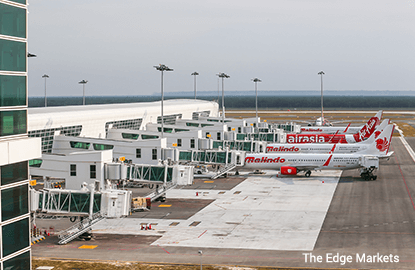
This article first appeared in Corporate, The Edge Malaysia Weekly, on July 11 - 17, 2016.
THE mouth-watering nasi lemak served on board and passengers’ excess baggage are earning good income for low-cost carriers (LCCs) such as AirAsia Bhd.
Not many may realise that ancillary services, such as check-in baggage, cancellation, seat selection and in-flight food and services, generated RM1.14 billion for AirAsia in the financial year ended Dec 31, 2015 (FY2015), an 11.2% year-on-year growth. The amount accounted for 18% of the LCC’s total revenue.
Check-in baggage is one of the highest ancillary revenue earners for LCCs.
According to AirAsia, it has fine-tuned its pricing mechanism for that segment, leading to a 9% y-o-y revenue growth in FY2015 from Baggage Supersize — a segment that contributes over 40% to its ancillary income — to RM469 million.
Ancillary income is also significant for its associate, AirAsia X Bhd. In FY2015, it made up 15.6% of the airline’s total revenue (20% in FY2014).
In 1QFY2016, AirAsia’s ancillary income per passenger went up 5% y-o-y to RM50. The average fuel price during the period declined to US$56 per barrel from US$79 a year earlier.
As for AirAsia X, its ancillary revenue grew 7% y-o-y to RM150. Its average fuel price was down 32% y-o-y to US$57 per barrel.
The rising ancillary income is fuelling AirAsia group’s earnings growth, which is already boosted by low fuel prices.
“The fall in oil prices is a major driver of profitability. That has been reinforced by airlines’ efforts, raising load factors to all-time highs, increasing ancillary revenue and improving aircraft utilisation,” says International Air Transport Association director-general and CEO Tony Tyler in IATA’s 2016 report.
IATA also notes that the break-even load factor is falling because of lower fuel prices and rising ancillary revenue.
To grow their ancillary incomes, both AirAsia and AirAsia X have set up teams to take care of this area. Several projects will be carried out to expand their ancillary offerings this year, including more efficient wheelchair services, enhanced crew management, improved on-time performance with better communication flow, increased in-flight sales with big data analysis and more effective seat selection services.
AirAsia group chief executive Tan Sri Tony Fernandes told The Edge recently that he is pushing for the group’s ancillary income to reach RM60 per passenger from RM40 currently.
“From RM20, we said we are going for RM40 and everybody laughed at us. We are there now,” he said.
“Where do we make money from our customers? They are going to spend it somewhere. Duty-free is a big push, foreign exchange as well ...
we are working on that.”
Industry analysts say airlines have been beefing up their ancillary services segment. “It has been ongoing for a couple of years, but it is more obvious now as the segment is making a more meaningful contribution to the earnings of airlines,” explains an analyst.
“Ancillary income provides airlines with a separate source of revenue to buffer against uncertainties. However, it can be uncertain as well and may not see continuous growth. That is why airlines have to be constantly on the ground finding out what their passengers want.”
It is that fast shift in equilibrium due to uncertain factors that has pushed airlines to diversify their income streams, says another local bank-backed analyst.
Maybank Investment Bank Research’s aviation analyst Mohshin Aziz, however, believes it still remains to be seen as to how effective ancillary income is to airlines.
“The acid test will be when oil prices and fares go up. At that time, it will be interesting to see if ancillary income would go up or down,” he tells The Edge.
“How much consumers are willing to spend on a flight depends on their total budget for the trip. If ticket prices are high, chances are they will not buy more add-ons. So, I believe it all boils down to the state of the market.”
Mohshin also believes the combination of buoyant passenger demand, short supply and low fuel prices will continue to lift the earnings of airlines going forward.
In a June 29 research note, he says 1Q2016’s supernormal profits were the result of this combination.
“Given that the dynamics are unchanged in 2Q2016 and perhaps 3Q2016 as well, we expect airlines to deliver supernormal profits in the subsequent quarters. Things will normalise when the industry deploys more aircraft, which should be the case in late 2016 and 2017,” he adds.
Save by subscribing to us for your print and/or digital copy.
P/S: The Edge is also available on Apple's AppStore and Androids' Google Play.